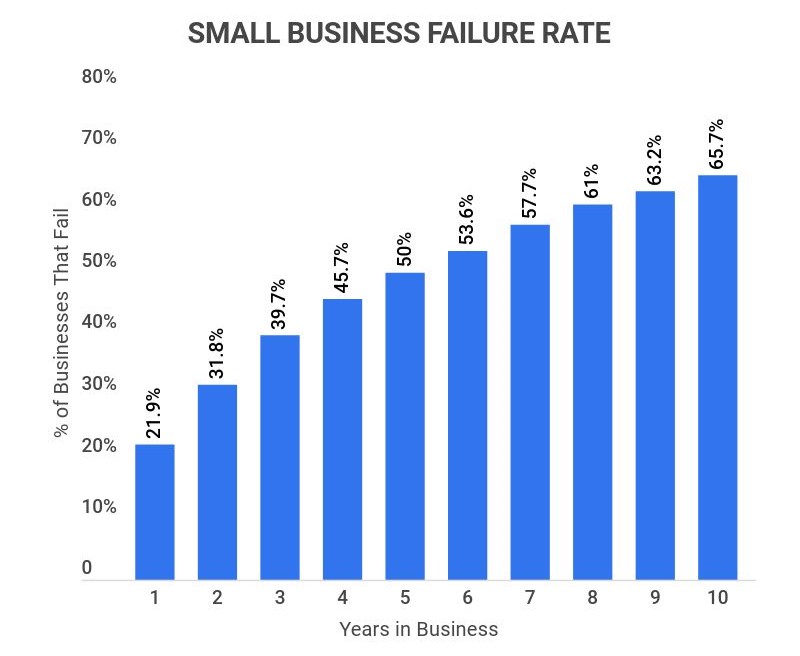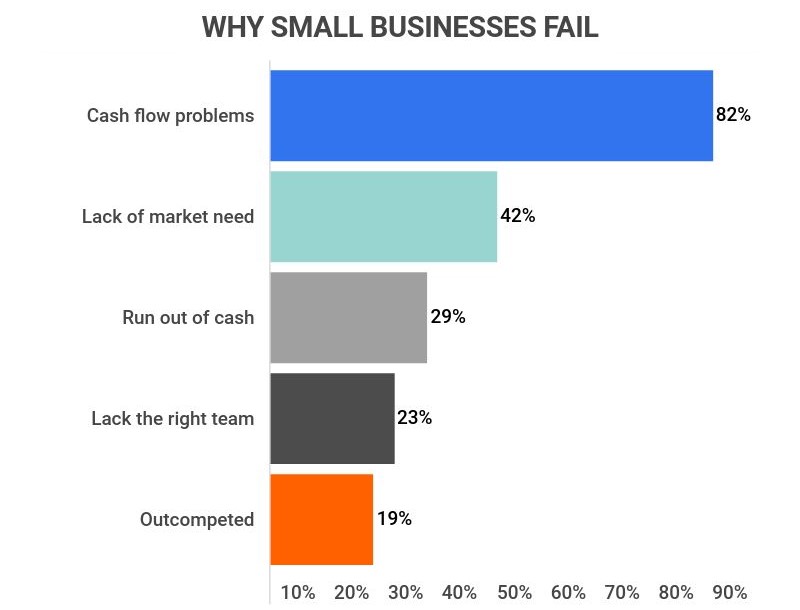Research Summary. When you’re starting a small business, your first thought is not how quickly you might fail. However, it’s an important statistic to be aware of when you begin any new venture. Understanding how and why businesses typically fail can save you from common mistakes that will help your business thrive. According to statistics:
-
22% of business startups fail in the first year
-
50% of new businesses fail within the first five years
-
The top reason why small businesses fail is cash flow problems.
-
Massachusetts is the state with the lowest failure rates, while Washington has the highest failure rates.
For further analysis, we broke down the data in the following ways:
Small Business | Top Reasons | Industry | State

Small Business Failure Rate Over Time
When you start a business, you’re in it for the long haul. However, the first few years of any small business are crucial. It’s important to understand failure rates within the first few years of business to ensure you cover all of your bases to stay afloat.
-
For a business in its first year of operation, the failure rate is 21.9%
This means the survival rate is around 78.1%, meaning the first year is typically relatively successful for many businesses.
-
For a business in its second year of operation, the failure rate is 31.8%, while the survival rate is 68.2%.
It’s important to note that as the years grow for businesses, the survival rate decreases while the failure rate increases. For those businesses in year three, the survival rate is 60.3%, while failure is 39.7%.
For those businesses in year four, the survival rate is 54.3%, and the failure rate is 45.7%, and for those in year five, the survival rate is 50%, while the failure rate is also 50%.
-
For businesses ten years into their journey, the failure rate is 65.7%.
This means the survival rate is 34.4% for businesses with a decade of business under their belts.
-
Businesses are most likely to fail in their first three years of operation.
Statistics show that businesses who make it to their fourth year have an approximately 90% chance of survival through each subsequent year.

Small Business Statistics
Now that we understand the business failure rate, we should understand how many small businesses this affects. The small business market can feel incredibly saturated, but considering how many different industries and markets businesses can reach, the numbers may surprise you.
-
Over 627,000 new businesses open each year.
According to the Small Business Association (SBA), this is making the small business market a fairly substantial size.
-
In contrast, about 595,000 businesses close each year.
This number demonstrates just how easy it is to lose a business, no matter how much experience you may have under your belt.
-
There are 28.8 million small businesses in the United States.
97% of all businesses in the United States are small businesses or have less than 100 employees.
Top Reasons Why Small Businesses Fail
Now that we know the numbers behind the small business market, it’s also important to understand why these businesses ultimately fail.
-
The top reason small businesses fail is that they experience cash flow problems.
82% of small businesses that fail experience cash flow problems, while 42% find an insufficient need for their product or service. 29% run out of cash, 23% don’t have the right team, and 19% are out-competed.
-
Some 42% of small business owners applied for a business loan at a large bank in 2020, while 43% of small business owners applied at a small bank.
Online lenders received about 20% of all business loan applications.

Small Business Failure Rate by Industry
Although all small businesses run into common issues, there are differences based on your product, service, market, and industry. Consider the following:
-
The worst industries for small business survival are transportation and warehousing and construction.
75% of transportation and warehousing small businesses survive their first year, but that number drops significantly by their 5th year, with only 30% of small businesses surviving.
75% of construction small businesses also survive their first year, but by their 5th year, only 40% are projected to survive.
-
Health care and social assistance are the best industries for small business survival.
85% of healthcare and social assistance small businesses survive their first year. By year 5, 60% of these businesses are still successful.
-
Statistics show restaurants do not fail more than other businesses.
The foodservice market is misunderstood by many. Banks often perceive this industry as high risk and are less willing to lend startup money.
Small Business Failure Rate by Industry
| Industry | % Failure Rate (2015) | % Failure Rate (2016) | % Failure Rate (2017) | % Failure Rate (2018) | % Failure Rate (2019) |
|---|---|---|---|---|---|
| Agriculture, Forestry, Fishing & Hunting | 29 | 25 | 20 | 20 | 12 |
| Real Estate, Rental & Leasing | 35 | 31 | 25 | 24 | 14 |
| Retail Trade | 38 | 33 | 27 | 24 | 15 |
| Arts, Entertainment, & Recreation | 40 | 33 | 27 | 25 | 17 |
| Accommodation & Food Services | 41 | 34 | 30 | 26 | 17 |
| Manufacturing | 39 | 33 | 29 | 26 | 17 |
| Utilities | 41 | 37 | 30 | 25 | 18 |
| Educational Services | 42 | 35 | 30 | 26 | 18 |
| Health Care & Social Services | 44 | 40 | 33 | 25 | 20 |
| Finance & Insurance | 43 | 39 | 33 | 29 | 18 |
| Construction | 42 | 37 | 32 | 30 | 21 |
| Management of Companies & Enterprises | 47 | 42 | 35 | 32 | 19 |
| Transportation & Warehousing | 47 | 42 | 33 | 32 | 23 |
| Wholesale Trade | 48 | 41 | 35 | 30 | 20 |
| Professional, Scientific & Technical Services | 49 | 43 | 37 | 33 | 22 |
| Administrative & Waste Services | 47 | 43 | 37 | 33 | 24 |
| Mining, Quarrying, & Oil and Gas Extraction | 59 | 49 | 37 | 34 | 23 |
| Information | 53 | 47 | 40 | 36 | 24 |
Small Business Failure Rate by State
Your location may also matter when developing your own small business. States rank differently on their survival and failure rates. The statistics below demonstrate just how different businesses perform based on their location.
-
Over the past five years, Massachusetts has been the state with the lowest cumulative failure rate.
In 2019, Massachusetts had a 19.5% failure rate. Montana comes in second place, with a 2019 failure rate of 19%. Third place goes to California, with a 2019 failure rate of 18.2%. In fourth place is Minnesota, with a 2019 failure rate of 19.9%. Finally, in fifth place is Iowa, with a 20.2% failure rate in 2019.
-
Over the past five years, Washington has been the state with the lowest cumulative failure rate.
In 2019, Washington had a failure rate of 36.6%, while the next state only had a failure rate of 22.3%. Third place goes to the District of Columbia, with a 2019 failure rate of 22.7%. Missouri came in fourth place, with a 2019 failure rate of 24%. Kansas is fifth, with a 2019 failure rate of 25.2%.
States With The Lowest Small Business Failure Rate
| State | % Failure Rate (2015) | % Failure Rate (2019) |
|---|---|---|
| California | 47 | 18 |
| Louisiana | 49 | 18 |
| Montana | 46 | 19 |
| Massachusetts | 46 | 19 |
| Idaho | 49 | 19 |
| Minnesota | 44 | 19 |
| New Mexico | 50 | 19 |
| Mississippi | 48 | 20 |
| Iowa | 46 | 20 |
| Texas | 49 | 20 |
| New Jersey | 50 | 20 |
States With The Highest Small Business Failure Rate
| State | % Failure Rate (2015) | % Failure Rate (2019) |
|---|---|---|
| Washington | 53 | 36 |
| Michigan | 52 | 28 |
| Kansas | 51 | 25 |
| Hawaii | 51 | 24 |
| Rhode Island | 53 | 24 |
| Florida | 50 | 24 |
| Missouri | 53 | 24 |
| Delaware | 54 | 23 |
| Georgia | 53 | 23 |
| Maryland | 49 | 23 |
| New Hampshire | 54 | 23 |
What Percentage of Small Businesses Fail FAQ
-
What industry has the highest small business failure rate?
The transportation and warehousing industry and construction industry tie in having the highest small business failure rate.
-
How many small businesses close each year?
595,000 businesses close each year.
-
What percent of small businesses closed in 2020?
60% of businesses that closed during the COVID-19 pandemic in 2020 are permanent closures.
-
How long do most small businesses last?
The average length of a small business is about eight and a half years. 51% of small businesses are ten years old or less.
-
What industry has the highest small business failure rate?
The transportation and warehousing industry has the highest small business failure rate. The failure rate for first-year transportation and small warehousing business is 25%, which means that 75% survive through their first year of operations.
However, most of the time, experts also study the failure rates of small businesses through their fifth year of operation to get a complete picture of their success rates, and this industry has a five-year failure rate of 70%. This means that just 30% of transportation and warehousing small businesses are still around by what would be their sixth year in business.
Small businesses in the construction industry aren’t far behind those in the transportation and warehousing industry, as they also have a 25% first-year failure rate, but only 40% survive through their fifth year, which means this industry has a five-year failure rate of 60%.
-
How many small businesses close each year?
595,000 businesses close each year in the United States. While this may seem like a significant number (and it is), 627,000 businesses also open each year, offsetting the number that doesn’t make it by about 32,000.
For additional context, there are 28.8 million small businesses in the United States and these account for 97% of all U.S. businesses.
The average business failure rate during the first year of operation is 21.9%, and this only goes up as the years go on. Companies are the most likely to fail in their first three years of business, so if you can make it to your fourth year, you’ll be in good shape, although you won’t be totally out of the woods – businesses that are ten years old still have failure rates of 65.7%.
-
What percent of small businesses closed in 2020?
9% of small businesses closed in the second quarter of 2020. This is four percentage points higher than the average closing rates of 2019. During the first quarter of 2020, 6% of establishments closed, which was not significantly higher than the 5% that closed throughout 2019, but it was still higher.
In numerical terms, more than 1.2 million businesses closed in the first half of 2020 alone (data isn’t available for the second half at this time), which exceeds the average quarterly losses 2019 saw by almost 300,000 businesses. These 2020 establishment closures also resulted in about 3 million job losses.
The Federal Reserve estimates that, based on historical trends, about half of these closures will be permanent, but it won’t be able to truly tell how many businesses were killed by the COVID-19 pandemic for a few years yet.
-
How long does the average small business last?
The average small business lasts about eight and a half years. 51% of small businesses are ten years old or less, and 50% fail within the first five years. Most small business owners think that if they can make it past the first year, they’re good to go, and while this is a huge first step, in reality, it’s the first four or five years that are the first big milestone to aim for.
The sad fact is that failure rates go up each year of a business’s life, reaching 65.7% by the time someone has been in business for ten years. The most common reason why small businesses fail at any point is cash flow problems, which means they have more cash going out than coming in.
This doesn’t necessarily mean that the company has run out of cash, but it often means it’s all tied up in customer credit, inventory, or other locations where it’s difficult to use it to pay bills or loans. This is an easy hole for entrepreneurs to find themselves in, which is why cash flow problems play at least some part in 82% of small business closures.
-
What type of business is most likely to succeed?
Healthcare and social assistance small businesses are the types of businesses that are the most likely to succeed. These types of establishments only see 15% failure rates in their first years of operation, and 60% usually make it to year five of being in business.
These high success rates are often due to the fact that these businesses provide essential services to their communities that may have been underserved in those services before these businesses opened. In addition, no matter what’s happening in the world, everyone needs medical care and social assistance, which all but guarantees customers for these establishments.
As far as business success rates in specific years go, however, in 2019, agriculture, forestry, fishing, and hunting businesses saw the lowest failure rate at 12%, which was a much lower rate than businesses in this industry usually see.
Healthcare and social assistance businesses still hold the overall title of most likely to succeed, but this is an unusually low failure rate worth mentioning.
Conclusion
Starting your own business can bring a lot of uncertainty. One thing is for sure; you’ll want to do everything you can to ensure your success as a business.
Opening a small business is a risk in itself, but the numbers aren’t as scary as many make them out to be. Having all of the facts in front of you can help you make an educated decision about how you want to grow your business.
When you look at the big picture, the main takeaway is that running your own business is hard. There are many reasons small businesses fail, but keeping an eye on your finances and cash flow is statistically the most important thing you can pay attention to. This is often the final nail in the coffin for many small businesses forced to close their doors.
Regardless, there are plenty of opportunities and innovations to be made out there in the market. The strengths of small businesses in the United States are demonstrated by growing statistics each year.
References
-
AdvisorSmith. “What Percentages of Small Businesses Fail?” Accessed November 17, 2021.
-
Chron. “Information on Small Business Startups.” Accessed November 17, 2021.
-
Visual Capitalist. “Why Do Businesses Fail?” Accessed November 17, 2021.
-
Insider. “Here’s why small businesses fail.” Accessed November 17, 2021.
-
Finder. “Business loan statistics.” Accessed November 17, 2021.





